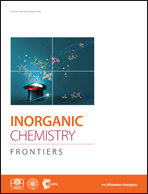Theoretical studies on the chiral polyoxoanions [P2Mo18O62]6− and [PMo9O31(OH2)3]3− with histidine: chiral inversion and chiral induction†
Abstract
Herein, the electronic structures and electronic circular dichroism (ECD) spectra of the chiral Wells–Dawson (W–D) polyoxoanion [(L,D-C6H10N3O2)P2Mo18O62]5− (1a/1b) and chiral polyoxoanion [(L,D-C6H10N3O2)PMo9O31(OH2)3]2− (2a/2b) are investigated using density functional theory (DFT) and time-dependent DFT (TDDFT) calculations. Compared to the fully oxidized [P2Mo18O62]6− structure, the Mo–Ob bond lengths in the one-electron reduced state, [P2Mo18O62]7−, tends to be average. It is reasonable that organic ligands can transfer electrons to POMs and affect their chirality. The energy difference between the chiral L-[P2Mo18O62]6− with D3 symmetry and ideal [P2Mo18O62]6− with D3h symmetry is 5.88 kcal mol−1, which suggests that chirality inversion may occur from the L-isomer to the D-isomer through the ideal [P2Mo18O62]6− by crossing a small energy barrier. Meanwhile, the interaction energy between the L-isomer and L-histidine ligand is larger than that of L-isomer and D-histidine, which indicates that L,D-[P2Mo18O62]6− is induced and further separated by the chiral histidine. The origins of the chiral polyoxoanion are mainly ascribed to charge-transfer (CT) transitions from the O atoms to Mo atoms or organic ligands to Mo atoms. These results confirm that organic cations have an induced effect on chiral POMs.
![Graphical abstract: Theoretical studies on the chiral polyoxoanions [P2Mo18O62]6− and [PMo9O31(OH2)3]3− with histidine: chiral inversion and chiral induction](/en/Image/Get?imageInfo.ImageType=GA&imageInfo.ImageIdentifier.ManuscriptID=C8QI00430G&imageInfo.ImageIdentifier.Year=2018)


 Please wait while we load your content...
Please wait while we load your content...